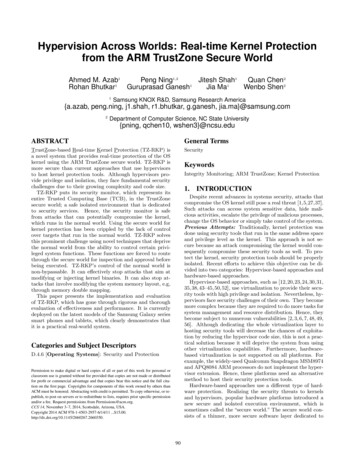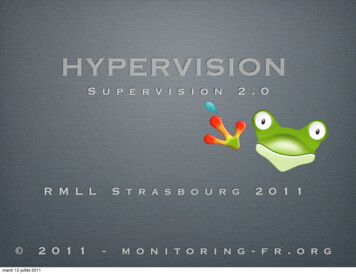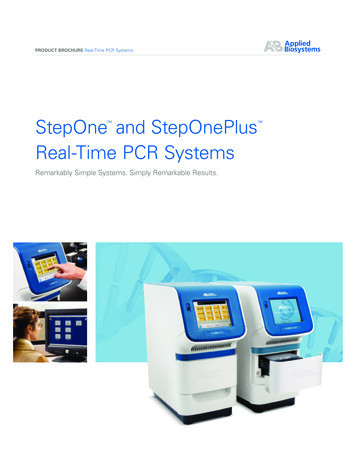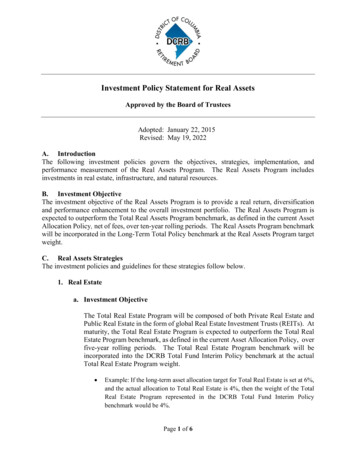
Transcription
Hypervision Across Worlds: Real-time Kernel Protectionfrom the ARM TrustZone Secure WorldAhmed M. Azab1Peng Ning1,2Jitesh Shah1Quan Chen2111Rohan BhutkarGuruprasad GaneshJia MaWenbo Shen21Samsung KNOX R&D, Samsung Research America{a.azab, peng.ning, j1.shah, r1.bhutkar, g.ganesh, jia.ma}@samsung.com2Department of Computer Science, NC State University{pning, qchen10, wshen3}@ncsu.eduABSTRACTGeneral TermsTrustZone-based Real-time Kernel Protection (TZ-RKP) isa novel system that provides real-time protection of the OSkernel using the ARM TrustZone secure world. TZ-RKP ismore secure than current approaches that use hypervisorsto host kernel protection tools. Although hypervisors provide privilege and isolation, they face fundamental securitychallenges due to their growing complexity and code size.TZ-RKP puts its security monitor, which represents itsentire Trusted Computing Base (TCB), in the TrustZonesecure world; a safe isolated environment that is dedicatedto security services. Hence, the security monitor is safefrom attacks that can potentially compromise the kernel,which runs in the normal world. Using the secure world forkernel protection has been crippled by the lack of controlover targets that run in the normal world. TZ-RKP solvesthis prominent challenge using novel techniques that deprivethe normal world from the ability to control certain privileged system functions. These functions are forced to routethrough the secure world for inspection and approval beforebeing executed. TZ-RKP’s control of the normal world isnon-bypassable. It can effectively stop attacks that aim atmodifying or injecting kernel binaries. It can also stop attacks that involve modifying the system memory layout, e.g,through memory double mapping.This paper presents the implementation and evaluationof TZ-RKP, which has gone through rigorous and thoroughevaluation of effectiveness and performance. It is currentlydeployed on the latest models of the Samsung Galaxy seriessmart phones and tablets, which clearly demonstrates thatit is a practical real-world system.SecurityKeywordsIntegrity Monitoring; ARM TrustZone; Kernel Protection1.INTRODUCTIONDespite recent advances in systems security, attacks thatcompromise the OS kernel still pose a real threat [1,5,27,37].Such attacks can access system sensitive data, hide malicious activities, escalate the privilege of malicious processes,change the OS behavior or simply take control of the system.Previous Attempts: Traditionally, kernel protection wasdone using security tools that run in the same address spaceand privilege level as the kernel. This approach is not secure because an attack compromising the kernel would consequently compromise these security tools as well. To protect the kernel, security protection tools should be properlyisolated. Recent efforts to achieve this objective can be divided into two categories: Hypervisor-based approaches andhardware-based approaches.Hypervisor-based approaches, such as [12,20,23,24,30,31,35, 38, 43–45, 50, 52], use virtualization to provide their security tools with high privilege and isolation. Nevertheless, hypervisors face security challenges of their own. They becomemore complex because they are required to do more tasks forsystem management and resource distribution. Hence, theybecome subject to numerous vulnerabilities [2, 3, 6, 7, 48, 49,56]. Although dedicating the whole virtualization layer tohosting security tools will decrease the chances of exploitation by reducing the hypervisor code size, this is not a practical solution because it will deprive the system from usingother virtualization capabilities. Furthermore, hardwarebased virtualization is not supported on all platforms. Forexample, the widely-used Qualcomm Snapdragon MSM8974and APQ8084 ARM processors do not implement the hypervisor extension. Hence, these platforms need an alternativemethod to host their security protection tools.Hardware-based approaches use a different type of hardware protection. Realizing the security threats to kernelsand hypervisors, popular hardware platforms introduced anew secure and isolated execution environment, which issometimes called the “secure world.” The secure world consists of a thinner, more secure software layer dedicated toCategories and Subject DescriptorsD.4.6 [Operating Systems]: Security and ProtectionPermission to make digital or hard copies of all or part of this work for personal orclassroom use is granted without fee provided that copies are not made or distributedfor profit or commercial advantage and that copies bear this notice and the full citation on the first page. Copyrights for components of this work owned by others thanACM must be honored. Abstracting with credit is permitted. To copy otherwise, or republish, to post on servers or to redistribute to lists, requires prior specific permissionand/or a fee. Request permissions from Permissions@acm.org.CCS’14, November 3–7, 2014, Scottsdale, Arizona, USA.Copyright 2014 ACM 978-1-4503-2957-6/14/11 . 15.00.http://dx.doi.org/10.1145/2660267.2660350.90
hosting security services. Moreover, it has both limitedinterface with the normal world and hardware protectionagainst illegal memory access from the normal world kernelor hypervisor. Examples of the secure world include IntelTXT [29], AMD SVM [8] and ARM TrustZone [9].Hardware-based approaches, such as [13, 41, 55], use thesecure world to host kernel security protection tools. However, these systems are crippled by their inability to closelymonitor events that happen inside the target kernel. Therefore, they do periodic kernel integrity checking, which haslimited effectiveness because it can only detect attacks after they have already happened. Moreover, it can miss theattack altogether, if the traces are properly hidden.In summary, previous research shows that using the hypervisor for kernel protection has security risks. At thesame time, hardware-based isolation lacks a critical capability, which is event-driven monitoring. Hence, there is atrade off between the isolation provided to the security tooland the control it possesses over the system to be measured.Introducing TZ-RKP: TrustZone-based Real-time KernelProtection (TZ-RKP) provides the basic architecture required to protect the OS kernel using a security monitor thatis entirely located within the secure world of ARM TrustZone. TZ-RKP enjoys the strongest possible isolation frompotential attacks. At the same time, it gives the securitymonitor full control over the target kernel’s memory management. Moreover, it can intercept critical events and inspect their impact on security before allowing them to getexecuted. As a result, TZ-RKP solves the dilemma thatprevious approaches face because it does not have to tradeoff between isolation and effectiveness.Current TZ-RKP design relies on hardware features thatare specific to the ARM architecture, which is used by themajority of today’s mobile devices. Mobile devices, suchas smart phones and tablets, are getting more ubiquitous.They also expose many interfaces and carry sensitive data,hence compromising the kernel of such devices can causedevastating consequences [15]. Having a trustworthy kernelallows the target platform to have a secure foundation thathardens the security of higher level system components.Technical Challenges: A security protection tool runningin the TrustZone secure world has two main technical challenges. First, the normal world, which hosts the target OS,has full control over its own resources, such as its physical memory and its Memory Management Unit (MMU). Intuitively, such control would allows attackers that exploitthe normal world to bypass any regular security monitoringtechnique. For instance, attackers can change the locationof interrupt handlers to create invisible hooks that hijackthe kernel’s control flow [22].Second, the TrustZone secure world is not capable of intercepting many of the critical events that occur in the normalworld, e.g., page fault exceptions and execution of systemcontrol instructions. If these events are not trapped by thesecure world, their impact on the system security can gounnoticed by the security monitor.An Overview of TZ-RKP: TZ-RKP achieves two important objectives. First, it completely prevents running unauthorized privileged code on the target system, which is accomplished by preventing modification of the target kernelcode, injection of unauthorized code into the kernel, or execution of the user space code in the privileged mode. Second,it prevents kernel data from being directly accessed by userlevel processes. This includes preventing double mapping ofphysical memory that contains critical kernel data into userspace virtual memory. This is an important step towardcomplete security protection of the kernel using TrustZone.In the proposed architecture, the security monitor runs inthe TrustZone secure world, while the kernel to be monitoredruns in the normal world. For convenience, we refer to thethe security monitor as TZ-RKP and to the OS kernel beingmonitored as “the kernel.”TZ-RKP provides two features that allow for an effective kernel protection: (1) Event-driven monitoring of thenormal world critical events, and (2) memory protection ofcritical parts of the normal world memory.The first feature, event-driven monitoring, is enforced bydepriving the kernel from its ability to control certain critical functions. Hence, it is forced to route requests to perform these functions through TZ-RKP. These functions include system control instructions and updates to the memory translation tables.TZ-RKP instruments the kernel so that certain systemcontrol instructions are removed from its executable memory, which is the only memory that can execute privilegedinstructions in the normal world. The removed system control instructions are the ones that allow the normal worldto control security critical system state, such as defining thelocation of memory translation tables and exception handlers. Therefore, the only way to execute these instructionsis through emulating them from the secure world. We callthis operation Control Instruction Emulation.Memory translation tables, a.k.a. page tables, define thevirtual to physical address mapping and the access permissions of virtual memory. TZ-RKP ensures that translationtables cannot be modified by the normal world. Moreover,it modifies the kernel so that requests to update the translation tables are routed through the secure world.The second feature provided by TZ-RKP is memory protection, which ensures that the target kernel cannot be modified. It also prevents kernel code injection and return-to-userattacks. Memory protection plays an important role to guarantee that monitoring is non-bypassable. It also provides anew method to prevent kernel critical data from being directly accessed by potentially malicious user processesThe core TZ-RKP techniques presented in this paper werefirst invented and recorded in a provisional patent submittedon August 2012. Afterwards, a patent application that ispublicly accessible was submitted on March 2013 [11].Currently, TZ-RKP is implemented and deployed on recent models of Samsung Galaxy smartphones and tablets, including Samsung Note 3 and Samsung S5 smartphones, protecting millions of these devices. These models are amongthe most advanced mobile devices on the market today. TZRKP is deployed as a part of the TrustZone-base IntegrityMeasurement Architecture (TIMA), which provides a suiteof TrustZone integrity measurement and security services onSamsung smartphones and tablets [47].TZ-RKP demonstrates that the security provided by TrustZone does not have to be limited to executing isolated applications; it can be extended to provide non-bypassable security protection for the running OS. TZ-RKP has been subject to rigorous evaluation. The results show that it is feasible to implement with minor instrumentation of the kernel,resulting in an acceptable performance overhead.91
Summary of Contributions: We make several technicalcontributions in this paper:return oriented attacks [28,51]. Unfortunately, these attackscannot be currently prevented or detected by TZ-RKP.Although TZ-RKP cannot prevent the third category ofkernel attacks, this does not undermine its security valuefor two main reasons. First, TZ-RKP’s active monitoringand memory protection does not rely on the target kernel.Hence, these attacks cannot bypass TZ-RKP’s control ofsystem critical functions, even if they compromise the kernel control flow. In other words, attackers cannot changethe state of the MMU, memory translation tables or evenswitch among different processes without passing throughTZ-RKP. These forced hooking points provide a secure basefor anomaly detection mechanisms, such as [33], to detectthe presence of these vulnerabilities.Second, many of the vulnerabilities found in the kernel allow limited access to kernel data, which sometimes preventattackers from accessing certain critical memory areas, suchas the kernel stack. This limited access would prevent kerneldata attacks from doing effective damage through controlflow hijacking. For example, a theoretical return-orientedattack would require a complete manipulation of the kernel stack to allow the attack code to jump to multiple codegadgets. Such manipulation cannot be achieved if the vulnerability only allows the attack to corrupt a single returnaddress or a limited range of the kernel memory. In thesecases, TZ-RKP would prevent the damage that can resultfrom having these vulnerabilities exploited by attacks of thefirst or the second categories.Assumptions: TZ-RKP assumes an ARM-based architecture that implements the TrustZone extensions. It also assumes that it runs as a part of the secure world, while thetarget OS runs in the normal world. TZ-RKP also assumesthat the whole system is loaded securely, including both thesecure and the normal worlds. This process is straightforward using trusted boot. Intuitively, trusted boot only guarantees the integrity of the kernel during the boot-up process.It cannot guarantee the integrity of the kernel after the system runs and starts to interact with potential attackers.TZ-RKP also assumes that the kernel can function properly using W X memory mapping (i.e., using mutually exclusive memory pages for data and code). Finally, TZ-RKPassumes that the hardware platform implements the Privileged eXecute Never (PXN) memory access permission asdefined by the ARM specifications. We provide a complete and feasible solution for kernelprotection using TrustZone, which is the most securecomponent of the ARM architecture. We provide techniques that allow the secure world tocontrol certain critical functions of the normal world.This allows non-bypassable event-driven monitoring ofthe normal world, which solves the main challenge thatfaced previous approaches. We provide techniques to guarantee a non-bypassablememory protection of the normal world’s critical memory regions. We provide a novel memory protection technique toprevent unauthorized direct access of kernel data. We present full implementation and rigorous evaluation of TZ-RKP using advanced mobile devices.This paper is organized as follows: Section 2 discussesour assumptions and threat model. Section 3 provides required background information. Section 4 presents TZ-RKPin detail. Section 5 presents our implementation. Section 6presents our experimental evaluation. Section 7 presents related work. Section 8 concludes this paper with some futureresearch directions.2. THREAT MODEL AND ASSUMPTIONSThreat model: Threats against the OS kernel are dividedinto three main categories.The first category includes attacks that aim at executing unauthorized privileged code inside the normal world.This includes all attacks that aim to: (1) inject maliciouscode into the kernel, (2) modify privileged code binariesthat already exist in memory or (3) escalate the privilegeof user space code. A real world example of these attacksis vroot [5], where the adversary modifies a kernel functionpointer to jump back into a malicious user space code in theprivileged mode. TZ-RKP prevents all these attacks without relying on the target kernel itself.The second category includes attacks that use maliciousdouble mapping to modify kernel data. These are specialclass of data attacks that exploit kernel vulnerabilities togenerate user space mapping of kernel memory. A real worldexample of these attacks is motochopper [1]. TZ-RKP prevents this type of attacks, but this protection relies on thekernel to provide information about its own memory usagefirst. This information is provided before the designatedmemory areas are used to store data. Hence, the kernel datadouble mapping protection is effective on all kernel memoryranges before they become a valid target for attackers.The third category includes another type of data attacks,where an adversary exploits a vulnerability to trick the kernel to directly change one or more critical data fields insideits own memory. A real world example of these attacks istowelroot [27], which uses a pointer manipulation vulnerability to modify the data field that defines process credentialsleading to privilege escalation. Attackers may also exploitthese vulnerabilities to modify control flow data, such asfunction pointers or return addresses. In this case, these attacks can escalate to hijack the kernel control flow, such as3.BACKGROUNDTZ-RKP relies on some hardware features of the ARM architecture. These features include fixed length instructions,control of privileged mode memory, and the TrustZone security extension.ARMv7 uses memory aligned instructions that have afixed length of either 16 bits for the Thumb mode or 32 bitsfor the ARM mode. This is in contrast to other architectureslike x86, where the instructions can be located at any offsetin memory. Having a fixed-length aligned instruction set allows TZ-RKP to restrict the presence of certain instructionswithin the normal world kernel.ARM provides two code execution modes; privileged andunprivileged. It provides control flags that prevent certainvirtual memory pages from executing privileged code. It alsoprovides control flags to mark certain memory areas, such asthe kernel memory, as privileged. It prevents unprivilegedcode from accessing privileged memory. Intuitively, the un-92
4.1Control Instruction EmulationControl instructions change the system state, and hencemay impact the system security. Thus, TZ-RKP implementsa novel technique to deprive the target kernel from the ability to execute certain instructions so that it is forced to routethe execution to TZ-RKP to emulate these instruction.In the widely used ARMv7 32-bit architecture, controlinstructions are done by writing to certain coprocessor register, which can only be done by the two privileged ARMinstructions LDC and MCR. In this section, we use this particular architecture to demonstrate our technique. Nevertheless,the same technique works on the 64-bit ARMv8 architecturethat uses direct control instructions, rather than coprocessorregister writes.To achieve control instruction emulation, TZ-RKP overcomes a key TrustZone limitation; the secure world is notcapable of preventing and intercepting control instructionexecution in the the normal world. It is worth noting thatthis limitation is not specific to TrustZone. Although hypervisor extensions usually allow for event interception, isolatedexecution environments do not usually provide this feature.The solution is to remove certain control instruction fromthe normal world and replace them by hooks so that theycan be emulated by TZ-RKP. Nevertheless, providing a nonbypassable guarantee for this solution is not straightforward.Our technique to make this solution secure is based onthree distinct hardware features. First, instructions thatchange the system state are always privileged and cannotbe executed in the unprivileged execution mode. Second,ARM virtual memory system allows restricting certain memory ranges from executing privileged instructions using thePrivileged eXecute Never (PXN) access restriction. Therefore, privileged instructions, such as LDC an MCR, are onlyallowed to be fetched, i.e., executed, from certain memoryareas. Finally, the ARM instruction set requires instructionsto incorporate both the opcode and operands in either 16-bitTHUMB mode or 32-bit ARM mode aligned memory.Based on these properties, the technique to solve thisproblem can be summarized in the following principle:Figure 1: TZ-RKP Basic Componentsprivileged mode is used to run the user process, while theprivileged mode is used to run the kernel. TZ-RKP relieson this access control mechanism to enforce its protection.TrustZone is a security extension defined by ARM. Thebasic idea is to logically partition the computing platforminto two execution domains: the normal world and the secure world. To facilitate context switch between the twoworlds, a special processor mode, known as the monitormode, is introduced. The monitor mode, which is part ofthe secure world, is the only entry point from normal worldto secure world. Execution jumps from the normal worldto the secure world by explicitly issuing the Secure MonitorCall (SMC) instruction. The secure world can access the fullrange of the physical memory and all hardware peripherals. It can also emulate the execution of normal world control instruction. On the other hand, some physical memoryranges and hardware peripherals can be restricted to be onlyaccessed by the secure world. Hence, these secure physicalmemory and hardware peripherals enjoy full hardware-basedprotections from attacks that can potentially compromisethe normal world.Given that (1) only certain memory regions aremapped with the permission to execute privileged instructions, (2) the same memory regionsare mapped with read-only permission and (3)the same memory regions do not contain a single memory word that matches the encoding of aparticular instruction, then it will be absolutelyimpossible for the normal world to execute thisinstruction, because it can neither find this instruction in its privileged executable memory norit can execute it from the rest of the memory.4. TZ-RKP DESIGNTZ-RKP can be implemented on any ARM processor thatsupports TrustZone. The design presented here solely relies on the architectural specifications defined by ARM [10].TZ-RKP can be customized to monitor any target OS. Thecurrent implementation is customized to target Android’sLinux Kernel. We use this implementation as an exampleto clarify our approach.Figure 1 shows the system architecture. TZ-RKP runs inthe TrustZone secure world, while the target kernel runs inthe normal world. The target kernel is forced to request TZRKP to perform two operations on its behalf: (1) emulatingcontrol instructions that change the system state and (2)updating the target OS memory translation tables.In the following, we present the control instruction emulation. Then, we present how TZ-RKP traps updates tomemory translation tables. Afterwards, we discuss how TZRKP uses these two features to achieve the required memoryprotection. Next, we present kernel data double mappingprevention. Finally, we summarize the security guaranteesprovided by TZ-RKP.All three conditions are achieved by TZ-RKP. It enforcesa strict policy that the whole normal world memory, except the memory range that hosts the verified kernel code,is mapped with the PXN flag set. It also enforces a policythat the target kernel is mapped read-only. The target OSmemory layout is shown in Figure 2. TZ-RKP uses its control of the normal world memory protection, which will bediscussed in Section 4.3, to enforce these policies.The third condition is satisfied by instrumenting the kernel to replace all the LDC and MCR instructions that targetspecific control registers with SMC instructions. The instrumentation can be either done by code modification or binary93
4.2Trapping Translation Table UpdatesTZ-RKP traps all updates to the memory translation tables so that it can always keep an up-to-date informationabout two key aspects of the memory layout: (1) the virtualto-physical mapping of the normal world memory and (2)the access permission of each memory page.The main challenge is the absence of a hardware-basedcontrol or a single entry point to update the translation tables. Translation tables can be anywhere in the physicalmemory. Therefore, translation table updates are normalmemory writes that can only be controlled by memory access permissions.The kernel creates a new set of translation tables for eachprocess it creates. When a process is scheduled, it modifiesthe TTBR register to point to the translation tables corresponding to that process. The translation tables can only beaccessed by the kernel. Hence, they should be only mappedwithin the kernel virtual memory range. They should neverbe mapped or accessed by a user process. Figure 2 showsthe typical virtual memory layout of the Linux kernel.The technique to intercept translation table updates startsby depriving the kernel from its own ability to do these updates. Hence, it is forced to request their modifications fromTZ-RKP in the secure world.This is achieved by modifying the access permissions ofthe kernel virtual address space so that the memory hosting translation tables become read-only memory. As discussed in Section 4.1, TZ-RKP intercepts writes to the TTBRregisters. Hence, it detects the physical address of translation tables, before they are actually used. At that point,TZ-RKP modifies the kernel address space mapping to ensure that these new translation tables are mapped read-only.This process starts when the kernel boots up and is repeatedwith every new process that starts in the normal world.Now that all translation tables are non-writable by thekernel, they are only modifiable by the secure world. Whenever the kernel needs to modify the translation tables, itsends a request to TZ-RKP. This can be done by either oneof two ways. First, the kernel code can be modified to callthe SMC command instead of writing the translation tables.TZ-RKP would intercept the request and carry it over onceit verifies the new translation table entries. Second, the kernel can be instrumented so that the page fault handler isreplaced by an SMC instruction. Hence, page faults will trapinto TZ-RKP, which in turn emulate the ones that originatefrom writing translation table entries. The second methodis described in more detail in Section 5.2.Security Guarantee: Trapping updates to translation tables is non-bypassable if two requirements are met: 1) thekernel is not able to hide its translation tables from TZRKP, and 2) the kernel is not able to modify its translationtables without TZ-RKP’s knowledge.As long as control instruction emulation is non-bypassable, the first requirement will be satisfied because the kernel cannot use its translation tables without updating theTTBR hardware registers. The second requirement is satisfied through TZ-RKP’s memory protection feature, whichwill be discussed in detail in Section 4.3.Trapping translation table updates does not require trustin the kernel even if the implementation relies on the kernel to explicitly request the translation table updates fromTZ-RKP. Since the translation tables are mapped read-onlyand cannot be modified by the kernel, there is no way forFigure 2: Target OS Virtual Memory Layoutrewriting. When TZ-RKP receives these SMC calls from thekernel, it emulates the required instruction by writing to thetarget control coprocessor registers from the secure side.Satisfying all three conditions leads to the definitive andunique situation that the target kernel cannot execute certain privileged instructions. Hence, it loses control over certain critical functions. In our case, we select the instructionsthat manage the normal world MMU and define the locationof exception handlers. Nevertheless, the same technique canbe extended to monitor other kernel functions.Security Guarantee: Control instruction emulation is bothsecure and does not involve complex implementation details.ARM enforces alignment and fixed size instructions thatinclude both the opcode and the operands within the sameword. Hence, each instruction can be represented by aunique set of words. For example, the layout of the MCRinstruction word incorporates all the parameters that definethe target register, which are the coprocessor number thecrn, crm, op1 and op2. Hence, it is easy to form a template of all MCR and LDC instructions that write to a specificcoprocessor register. TZ-RKP examines every word of thekernel executable binary and replaces all words that matchthis template with the SMC instruction. This template willnot match any other word within the kernel executable code,which eliminates any side effects of this operation.This technique is secure against control flow hijacking,including return oriented attacks. Since ARM instructionstake no operand to define the target register, no other wordcan be used to replace the write to the intended register evenif an attacker completely controls the flow of the kernel.For this technique to be secure, we have to emulate all therelevant control instructions. On ARMv7, four basic sets ofinstructions need to be emulated. First, system control registers, such as the SCTLR, that can disable the MMU, changethe location of the exception handlers or disable the enforcement of instruction alignment. Second, the translation tablebase registers that define the base address for translation table walks. Third, the domain access control registers, suchas the DACR, that can disable all the page table protectionfor select memory ranges. Fourth, the cache maintenanceregisters, such as NMRR and PRRR, which may need to bemonitored to avoid attacks based on cache poisoning.94
memory page against the stored state to verify that there isno violation to the memory protection. T
privileged mode is used to run the user process, while the privileged mode is used to run the kernel. TZ-RKP relies on this access control mechanism to enforce its protection. TrustZone is a security extension defined by ARM. The basic idea is to logically partition the computing platform into two execution domains: the normal world and the se-










